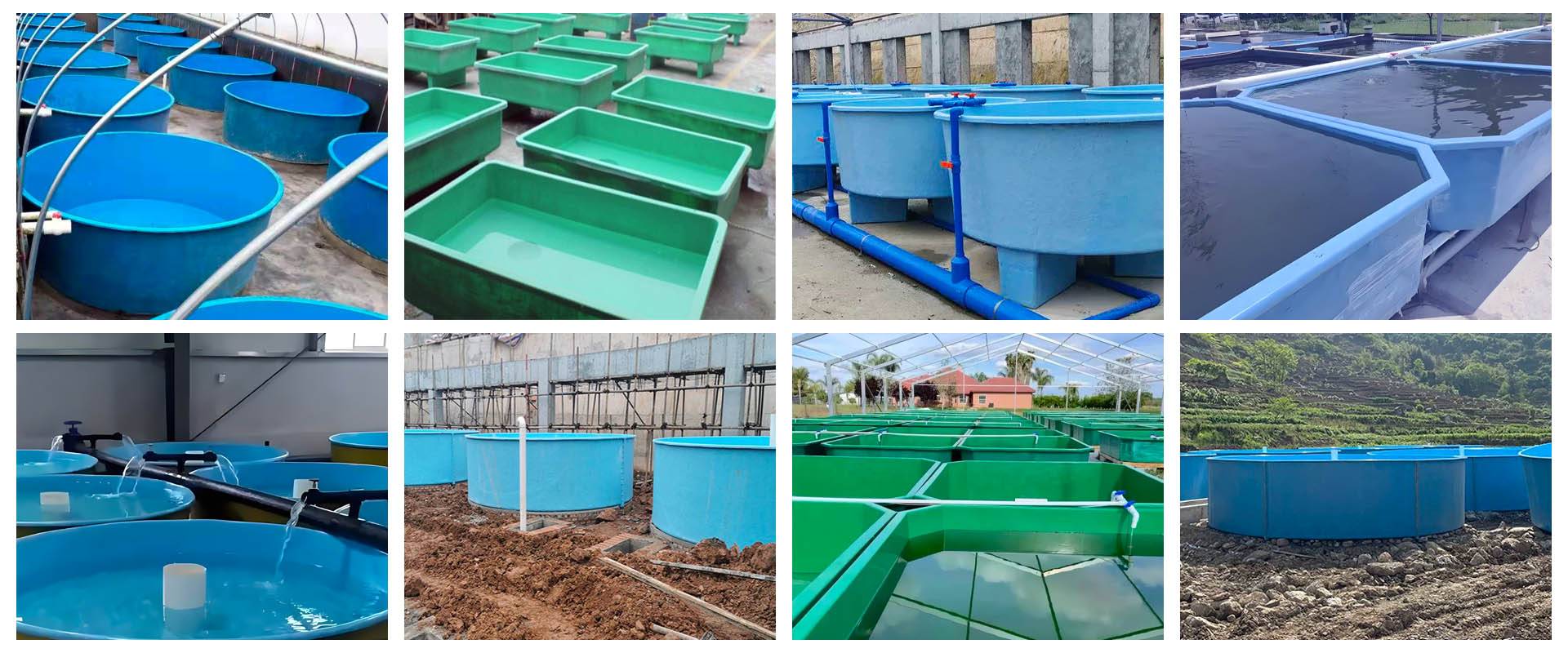FRP Fish Tank vs. Concrete vs. Plastic : Which is Best for Your Aquaculture Farm?
Are you planning to set up a fish tank but unsure which material to choose? The right tank material can make a huge difference in durability, maintenance, and overall success of your aquatic environment. In this article, we compare three popular options—Fiberglass Reinforced Plastic (FRP), concrete, and plastic fish tanks—to help you make an informed decision.
1. Durability & Lifespan
| Material | Lifespan | Resistance to Cracking/Corrosion |
|---|---|---|
| FRP (Fiberglass) | 25–40+ years | ✅ Excellent – Resistant to corrosion, UV, saltwater, and impact |
| Concrete | 15–30 years | ❌ Prone to cracking over time, especially with ground movement; vulnerable to saltwater erosion |
| Plastic (HDPE/PP) | 10–20 years | ✅ Good UV resistance, but can become brittle and deform under heavy loads or high temperatures |
Verdict: FRP wins for long-term structural integrity and resistance to environmental stress.
2. Maintenance & Cleaning
| Material | Surface Quality | Algae/Biofilm Buildup | Cleaning Effort |
|---|---|---|---|
| FRP | Smooth, non-porous gel coat | Minimal | ✅ Easy – quick rinse, low chemical use |
| Concrete | Rough, porous surface | High – algae and bacteria embed in pores | ❌ Difficult – requires scrubbing, high-pressure washing, frequent disinfection |
| Plastic | Smooth but can scratch | Moderate – scratches trap biofilm | ⚠️ Moderate – easier than concrete, but harder than FRP if scratched |
Verdict: FRP wins for hygiene and low maintenance—critical for RAS and hatchery operations.
3. Initial & Long-Term Cost
| Material | Upfront Cost | Long-Term Cost (TCO) |
|---|---|---|
| FRP | $$ (Higher initial cost) | ✅ Low – minimal repairs, low maintenance, long life |
| Concrete | $ (Lowest material cost) | ❌ High – labor-intensive construction, frequent repairs, high cleaning costs |
| Plastic | $–$$ (Moderate) | ⚠️ Moderate – may need replacement sooner; limited size scalability |
Verdict: While plastic and concrete may seem cheaper upfront, FRP offers the lowest total cost of ownership (TCO) over time.
4. Installation & Flexibility
| Material | Weight | Customization | Installation Time |
|---|---|---|---|
| FRP | ✅ Lightweight | ✅ Fully customizable (size, shape, fittings) | Fast – pre-fabricated, delivered ready to use |
| Concrete | ❌ Very heavy | ❌ Limited – requires on-site casting, fixed shapes | Slow – weeks of construction, curing, and finishing |
| Plastic | ✅ Lightweight | ⚠️ Limited – typically small to medium standard sizes | Fast – but scalability is limited |
Verdict: FRP wins for flexibility and speed, especially for large-scale or modular farms.
5. Hygiene & Water Quality
| Material | Toxic Leaching? | Seams/Joints | Water Quality Impact |
|---|---|---|---|
| FRP | No – food-grade resin | Seamless or bonded | ✅ Superior – stable, clean environment |
| Concrete | Possible – pH fluctuations, lime leaching | Many joints, cracks | ❌ Poor – porous surface affects water chemistry |
| Plastic | Generally safe | Seams in large tanks | ⚠️ Good if new and undamaged |
Verdict: FRP is the safest and most stable for sensitive species and RAS systems.
The best fish tank material depends on your specific needs, budget, and long-term goals. FRP tanks lead the pack in terms of durability and customization, while concrete tanks are ideal for large, permanent installations. Plastic tanks, on the other hand, are perfect for those just starting out.
Ready to explore more? Visit our website for detailed guides, expert tips, and the best fish tank solutions tailored to your needs!

Inquiry please contact:
Email : cn@chinaestop.cn
Whatsapp✆:+86 15350598856
Web: www.chinaestop.cn
————————————————————————————————————————
“ Wish to be your best partner in China! Welcome to visit our company”
